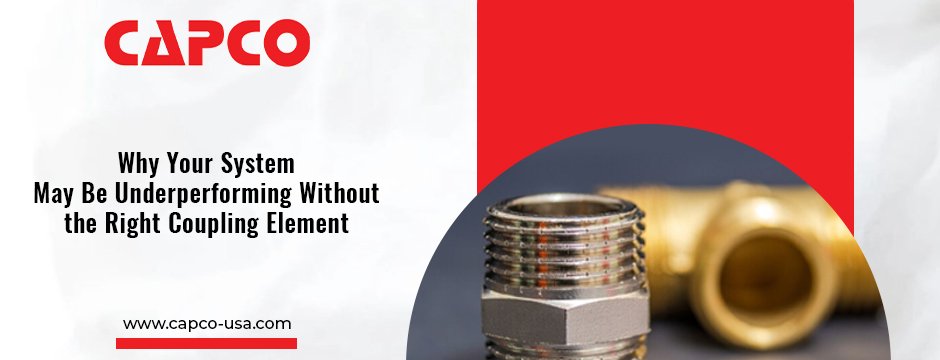
In any mechanical system, performance is dependent on how efficiently different components cooperate. One of the most neglected but very vital elements in that system is the coupling element. It plays a vital role in transmitting power, vibration dampening, and smooth operation between rotating shafts. Use the wrong coupling element, and your system might not operate as intended. In this blog, we’ll explore why choosing the right coupling element matters and how it can impact your machinery.
What Is a Coupling Element?
A coupling element is a mechanical device used to connect two rotating shafts. It allows for the transfer of torque and motion from one shaft to another. Coupling elements also help to accommodate misalignment, absorb shock loads, and dampen vibrations.
There are several types of coupling elements to select from, including flexible, rigid, and fluid couplings. Each plays a particular function depending on what the system demands. Choosing the right one is crucial to avoid performance problems.
How a Poor Coupling Choice Affects Your System
Incorrectly choosing the wrong coupling element can lead to various problems. The following are some of the most common ways your system ends up being affected.
1. Reduced Power Transmission Efficiency
The major role of a coupling is to transfer torque from one system element to another. If the coupling is not suitable for the torque requirement, it will slip or fail to transfer power efficiently. This causes loss of energy and renders your system less efficient.
2. Higher Vibration and Noise
Excessive vibration is the incorrect form of coupling. Vibration accelerates other parts in the system to wear out faster. Vibration results in noise, which can lead to a poor working environment or disturb adjacent equipment. A good coupling suppresses these vibrations and prevents the system from becoming unstable.
3. Misalignment Problems
There is no mechanical assembly that is perfectly aligned. A good coupling element will allow for slight misalignment of the shafts. If the coupling has no flexibility, it puts stress on the shafts, bearings, and other components. Ultimately, this leads to damage and costly downtime.
4. Premature Wear and Tear
It causes premature wear with an incompatible coupling element. Incompatible materials deployed to work under specific conditions crack, warp, or deteriorate very fast. It lessens the lifespan of the coupling as well as the surrounding parts.
5. Downtime and Frequent Maintenance
Bad coupling choices will cause more breakdowns. If the coupling does break down, the system must shut down for the repair. This unexpected downtime can lead to lost production and maintenance expenses. Alternatively, the proper coupling ensures smooth and uninterrupted operation.
Factors to Consider When Selecting a Coupling Element
To avoid the above challenges, you need to select a coupling that suits your system’s specific needs. The following are some of the key factors to keep in mind:
1. Torque Requirements
Determine how much torque your system needs to transfer. Make a choice of a coupling that can handle the required torque without slipping or failure.
2. Misalignment Tolerance
Quantify the kind and quantity of misalignment in your setup—angular, parallel, or axial. Choose a coupling that is resistant to and will compensate for these offsets.
3. Operating Environment
Consider the environment in which the system is operating. Extreme temperatures, chemical exposure, water vapor, and dust can affect coupling performance. Choose materials that will endure your operating conditions.
4. Speed of Rotation
If your system is running at high speeds, balance and stability are important. Choose a coupling with good high-speed performance to avoid vibration and noise.
5. Shock Load Capacity
Some systems undergo sudden or heavy loading. In these cases, the coupling needs to take shocks and protect other parts. The elastomeric coupling is widely used in such applications.
Signs That Your Current Coupling May Be Wrong
Not sure if your coupling is the issue? Watch for these indicators:
- Increased vibration or noise when loaded
- Continued bearing or shaft failure
- Symmetrical wear on mechanical parts
- Increased alignment problems
- Decreased machine performance or output
If you notice any of these indicators, the moment has arrived to inspect your coupling and replace it.
Benefits of Using the Correct Coupling Element
When you install the correct coupling in your system, especially in high-performance components like a compressor gearbox, the benefits are clear:
- Longer Equipment Life – There is less wear when vibration is controlled and alignment is maintained properly.
- Improved Efficiency – Efficient power transfer is more efficient, resulting in optimum system output.
- Low Maintenance Cost – Fewer breakdowns and repairs.
- Safer Operations – Less vibration and noise equal a safer environment.
- Consistent Performance – Smooth motion and consistent running ensure reliable results.
Consult Experts Before Choosing
It’s best at all times to consult a mechanical engineer or equipment supplier when selecting a coupling element. They can analyze your system’s needs and recommend the most appropriate solution. Investing a few dollars in the right component will save you a lot of time and money in the long run.
Final Thoughts
The coupling element is small, but its role in your system is massive. Selecting the incorrect one can cause performance degradation, increased maintenance, and even equipment failure. But the correct coupling provides silky-smooth, efficient, and reliable operation. Spend a little time selecting carefully, and your whole system will reward you.
Looking for the perfect coupling solution? Trust Capco USA—your reliable partner for high-performance coupling elements, compressor gearboxes, and precision-engineered mechanical components. Backed by expert knowledge and decades of industry experience, we deliver quality you can count on.




